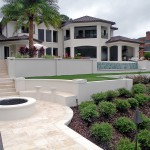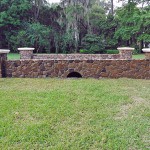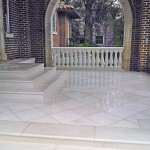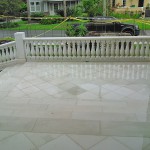Natural, Cultured, and Cast Stone Contractors
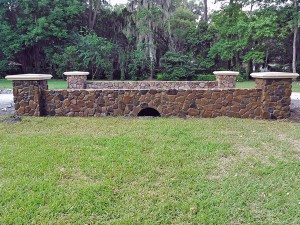
EK Birken Masonry stonework contractors are experienced with all types of stone, including natural, cultured, and cast stone, just to name a few. When installing stone, EK Birken Masonry contractors cut back on the amount of sand they use when mixing mortar. A normal batch of mortar consists of 18-20 shovels of sand to 1 bag of mortar. EKB Masonry will cut back to 14-15 shovels of sand, which makes the mixture stronger and stickier because there is more portland cement in the batch of mortar. Some companies will try and stretch the mortar by adding more sand because sand is less expensive than mortar. But adding more sand makes the mortar weaker. EKB Masonry also puts a bonding agent in its mortar to strengthen it, giving the customer the highest quality work.
EK Birken Masonry’s stonework is a cut above the rest. We’ll start by explaining the different types of stone and how they align with specific applications.
Stonework: Matching Material to Application
For example, porous stone and clay are poor choices for high-traffic areas because they’ll absorb more stains. Marble, slate, hard limestone, quartzite, and granite are most often used to build solid steps, platforms, treads, risers, saddles, and paving. Important considerations for selecting stone for this type of work are surface finish, resistance to wear, slip resistance, resistance to staining, and maintenance. The use of porous limestones and soft clayey sandstones is not recommended. High-traffic areas require less porous, harder stones as these are more resistant to staining and wear.
For external use, EK Birken Masonry contractors recommends the use of bluestone, granite, and other igneous rocks because they are more durable, resist weathering, and wear well. Abrasion resistance of stone selected for foot traffic may be determined with test methods described in ASTM C-241. Stone may become slippery when wet, therefore the following finishes are preferred for exterior use: tooled, flamed, sandblasted, or natural cleft.
Open joint pavers may be used on a plaza, terrace, or on a roof where the designer prefers cavity under the pavers and where the rainwater or melted snow can be led along a sloping subsurface to concealed drain holes. Granite pavers with non-slip finishes are usually selected for such installations.
For load-bearing applications, including rubble, ashlar, base, riser, lintel, and arches, we recommend high compressive strength stones with low water absorption rate and flexural strength with resistance to weathering, especially for outside applications.
For non-load-bearing installations, such as veneer, wall facing, curtain wall panels, column covers, soffits, wainscots, and door jambs, material selection will also be guided by appearance and physical characteristics. For interior use mainly aesthetic requirements govern. For exterior application low water absorption rate and high flexural strength with resistance to weathering are the most important functional requirements.
Stone Masonry: Building stones obtained by quarrying from the rocky strata of earth and reducing it to the required shapes and sizes for construction
Types of rock:
Igneous – Formed as a result of cooling of the molten rock to solid state – It is nonporous, hard, strong and durable
Granite: Consists mainly of quartz, feldspar, mica, and other colored minerals; colors include black, gray, red, pink, brown, buff, and green
Serpentine: Main ingredient is serpentine; color ranges from olive green to greenish black, is fine grained and dense
Basalt: Color ranges from gray to black; used mainly for paving stones and retaining walls
Sedimentary – Sediments deposited by the action of water or wind gets consolidated to a rock
Sandstone: Sedimentary rock composed of sand sized grains made of silica, iron oxide and clay; colors include gray, brown, light brown, buff, russet, red, copper, and purple
Shale: Derived from clays and silts; weak along planes and is in thin laminations; high in limestone and color varies from black to red, yellow, and blue
Stone Repair
In the stone industry it is understood that in the process of fabricating, shipping, and erection stone panel damage and/or breakage may occur. It is an accepted practice to repair damaged stone within certain limitations.
In addition, cracks and/or breakage sometimes develop – or may be discovered – after the stone has been installed. It is the accepted practice to repair such stones under the supervision of an experienced and responsible stone expert. Such repair work should be done by qualified masons who have been instructed in the proper procedure, usage of specified materials, and recommended methods.
What cannot be repaired? Any stone that has a crack, chip, or break that compromises or in any way affects the structural integrity or the structural anchorage of the unit to the backup is NOT to be repaired – but is to be replaced.
What can be repaired? Damaged stone that is determined to be repairable by an expert may be repaired by one of the following methods:
- Patching: For breaks less than 3/4″ in depth.
- Filling & Patching: For breaks larger than 3/4″ in depth.
- Bonding: Adhesion of stone to stone.
Patching. This is a process where chipped or broken out areas of stone are repaired by patching the void with an epoxy mortar mix. This method is used where the broken off pieces of stone are either not available and/or the size of the chipped area is under 3/4″ in depth. The subject area is to be examined to determine if the size of the break warrants, or can accommodate, “tie-in” dowel pins.
Filling and patching. Where the chipped or broken out area is larger than 3/4″ in depth and the broken off piece of stone is not available, the area must be prepared by filling in or building up the void area with a material especially manufactured and formulated for this particular application. Then, the final surface area is to be patched and dressed using an “epoxy mortar mix” as previously described.
Bonding. Bonding is used when an actual piece of the broken stone is available to be reattached and bonded back into place.
Stitching. When a cracked or broken stone is discovered on a building – after installation – it can be repaired by “stitching” if it is determined to be repairable by an expert.
Pinning. In addition to, or in place of “stitching,” cracked, broken, or loose stone can be pinned, if determined to be repairable by an expert.
Stonework Recommended Test Methods
AAMA 501.1 Test for Water Penetration using dynamic pressure.
ASTM E-283 Air Infiltration Test by static pressure.
ASTM E-330 Structural Load Test by uniform static pressure (positive and negative).
ASTM E-331 Water Infiltration Test by static pressure.
Stonework Anchoring
All stone cladding panels anchored to a building are subject to:
(1) Gravity load (the weight of the stone panel).
(2) Applied load (wind load, structural and thermal movement, seismic movement). The location, shape, and size of all anchors must be designed and calculated to safely support the stone for all stresses to which they may be subjected (compression, tension, bending, torsion). Inducing excessive stresses in the stone must be avoided.
Jointing Design
The specification, design, and detail of joints and sealants should be done by qualified persons and involve the evaluation of load bearing and non-load bearing joints, expansion joints, sealants, and flashing.
Don’t see what you’re looking for, or have a question or issue that’s not covered above? See examples of EK Birken Masonry’s previous work by visiting our gallery, or contact us to discuss your next project.
TYPES OF STONE MASONRY WALLS AND THEIR CONSTRUCTION
Types of Stone Masonry Walls:
- Solid masonry wall made by laying stone masonry over a prepared bed of mortar, and proceeding in a similar manner to increase the height;
- Composite wall made of an outer wall of large stone slabs, attached to a backing of structural frame or brick/concrete masonry wall; and
- Cavity wall made by two different types of masonry wall separated by a cavity, which is either insulated or empty and connected together by metal ties
Laying of stone masonry blocks in a wall:
- Rubble Masonry: Composed of unsquared pieces of stones; mason has to choose carefully each stone so that it can fit into the available space
- Ashlar masonry: Made of squared pieces of stones; mason has to carefully lift the heavy stones by a hoist and lower it into place
- Coursed stone masonry: has continuous horizontal joints
- Uncoursed or random masonry: Does not have defined bedding planes for the wall

